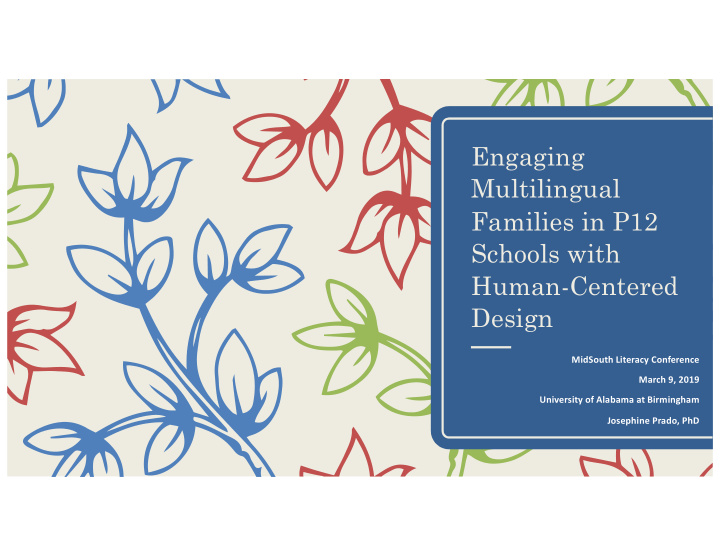



Engaging Multilingual Families in P12 Schools with Human-Centered Design MidSouth Literacy Conference March 9, 2019 University of Alabama at Birmingham Josephine Prado, PhD
In Today’s Talk, We will…. Define Examine Terms Ideas Explore Action Plan
Defining Terms
What is the Difference? Family Family Involvement Engagement
What Does Your School Do? Family Involvement Family Engagement – School Generated o Educators ask families for opinions and act upon – Government Mandated suggestions
What do Multilingual Families Look Like?
Multilingual Families…. – Speak more than one language at home. – Experience different amounts of cultural distance between school and home – May have recently immigrated to the United States – May have lived in the United States for generations
Exploring Ideas
Funds of Knowledge – Luis Moll, Cathy Amanti, and Norma Gonzalez (1992) developed this idea – Way of gathering knowledge – cultural, historical, and current about a child and his or her family. (HOW? Home visits, interviews or several conversations) – What is its purpose? – What benefits are there?
What is Human-Centered Design? – Design Process for the creation of new products (e.g., vacuum cleaners, baby products). The process empathizes with human struggles and strives to design a product that makes that struggle easier. – THREE COMPONENTS INSPIRATION – IDEATION – IMPLEMENTATION –
Human Centered Design for Families Inspiration OBSERVE & EMPATHIZE •Talk to people •Observe their lives •Step into their shoes to understand the problems and opportunities that exist for them Ideation DEFINE & IDEATE •Define the problem •Brainstorm different ideas for solving the problem Implementation PROTOTYPING & TESTING •Build a new plan •Test it out •Get feedback, evaluate and improve it
Case Study: Transition to Kindergarten OBSERVE. Committee of parents, teachers and administrators reflected on their – experiences with families transitioning to kindergarten. EMPATHIZE. Some members researched for guidelines to inform them of successful – transitions for families like theirs. DEFINE . Committee members identified the barrier for families. – IDEATE. Together, all members brainstormed ways to link families and communities. – PROTOTYPE . Members worked with clay, legos, straws, sticky notes, pipe cleaners – and popsicle sticks to build a prototype of the new connected community context. TEST. Members presented their ideas to different groups and demonstrated how – their prototype worked.
Your TURN! What can you Imagine? Test Ideate Prototype Observe Empathize Define
Thank you for your Kind Attention Josephine Prado, PhD jprado@uab.edu
References Hensley, M. (2005). Empowering parent of multicultural backgrounds. In N. Gonzalez, L. Moll., A. Amanti (Eds.) Funds of knowledge: Theorizing practices in households, communities, and classrooms (pp. 143-151). New York, NY: Routledge. Breiseth, L., Robertson, K, & Lafond, S. (2011). A guide for engaging ELL families: Twenty Steps for school leaders. http://www.colorincolorado.org/guide/guide-engaging-ell-families-twenty-strategies-school-leaders Global Family Research Project (2018). Human-centered design: An innovative tool for professional learning in family engagement. https://globalfrp.org/content/download/295/3154/file/GFRP_Human-CenteredDesignGuide.pdf NCELA (2018).https://ncela.ed.gov/files/family_toolkit/EL-Family-Tool-Kit-All.pdf TESOL (2018). Community and family toolkit. Alexandria, VA: TESOL PRESS https://www.tesol.org/advance-the- field/advocacy-resources/community-and-family-resources-for-elps Reyes, I., & Da Silva Iddings, A.C. (2016). Building relationships with diverse students and families: A funds of knowledge perspective. Journal of Early Childhood Literacy, 16 (1), 8-33.
Recommend
More recommend